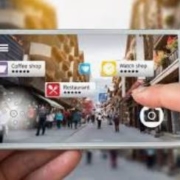Meet me in the metaverse The continuum of technology and experience, reshaping busines
Worlds of pure re-imagination
Tech Trends 2022: Meet Me in the Metaverse
The next wave of digital change is here, providing forward-looking companies with an opportunity to act today to be ready for the future.
Welcome to the Metaverse Continuum—a spectrum of digitally enhanced worlds, realities and business models poised to revolutionize life and enterprise in the next decade.
It applies to all aspects of business, from consumer to worker and across the enterprise; from reality to virtual and back; from 2D to 3D; and from cloud and artificial intelligence to extended reality, blockchain, digital twins, edge technologies and beyond. As the next evolution of the internet, the metaverse will be a continuum of rapidly emerging capabilities, use cases, technologies and experiences.
The Metaverse Continuum will transform how businesses interact with customers, how work is done, what products and services companies offer, how they make and distribute them, and how they operate their organizations.
Multiple worlds, multiple projects
The physical world is coming alive with new capabilities, environment by environment, each with its own rules. We already have small-scale intelligent physical worlds like smart factories, intelligent cruise ships and automated ports. Tomorrow we’ll see these grow into smart neighborhoods, cities and countries, where massive digital twins mirror physical reality. And purely digital worlds are expanding as well. Major companies will have their own internal metaverses to let employees work and interact from anywhere. In our free time, new consumer metaverses will transport us to almost any type of world we can imagine, to play games, socialize or relax.
While we are in the early days of the metaverse, leaders who shy away from the uncertainty of the metaverse will soon be operating in worlds defined by others.
Businesses will find themselves on the front lines of establishing safety and defining the human experience in these worlds. Trust will be paramount; existing concerns around privacy, bias, fairness and human impact are sharpening as the line between people’s physical and digital lives blurs. Leading enterprises will shoulder the charge for building a responsible metaverse, and are setting the standards now.
As these developments challenge our basic assumptions about technology and business, we’re entering a new landscape with no rules or expectations. It’s time to build and shape the worlds of tomorrow.
Architecting tomorrow’s continuum, today
Just like in the early years of the web, businesses are racing toward a future utterly different from the one they were designed for. Over the next decade, we will witness a complete transformation of nearly every environment in which companies do business.
The good news? There’s still time to get ahead—but companies need to start making decisive technology investments. At a minimum, they need to prioritize the remaining gaps in their digital transformation, from delayed cloud migrations to sidelined data and analytics programs.
But to really start this new journey, they must build on that digital foundation. It’s time to finally pick partners to build a digital twin, go beyond data and analytics to use AI in more visible and collaborative ways, or launch the “moonshot” project that increasingly feels mission critical. Only with a mature and well-oiled digital engine will enterprises be prepared to participate in (or build) new environments and worlds.
Meet Me in the Metaverse: four trends
In this year’s Tech Vision, we explore how today’s technology innovations are becoming the building blocks of our collective future. The trends investigate the entire continuum, from the virtual to the physical, across humans and machines alike.
The value of new virtual worlds would be capped if not for parallel changes that anchor them in the physical one. Programmable World tracks how technology exists in our physical environments in increasingly sophisticated ways. It projects how the convergence of new technologies like 5G are changing the way businesses interact with the physical world. We’ll soon be able to unlock an unprecedented level of control, automation and personalization.
We’re exploring the emergence of The Unreal—a trend where our environments are increasingly filled with machines that are passably human. “Unreal” qualities are becoming intrinsic to the AI, and even the data, that enterprises are using. But bad actors are using it, too—from deepfakes to bots and more. Like it or not, enterprises have been thrust into the forefront of a world questioning what’s real, what isn’t and if the line between those two really matters.
Finally, we will reset the boundaries of traditional industries as we begin Computing the Impossible. The outer limit of what is computationally possible is being disrupted as a new class of machines emerges. Quantum, biologically inspired and high-performance computers are each allowing companies to tackle the biggest challenges in their industries.
We stand at a unique precipice. There are new technologies to embrace but competing in this next decade will require something more than tech and innovation skills. It will require a truly competitive vision—both for what these future worlds will look like and for what your enterprise will need to become to succeed in them. Technology points us in the right direction, but the rest is up to you.
Putting the me in metaverse
The big picture
The internet is being reimagined, and enterprises need to be ready for what comes next.
For nearly two decades, businesses have built out a plethora of digital capabilities. But all of these solutions were created for the internet as we know it today: a digital world in which the platforms that drive value are often separate, where lack of interoperability and data portability are often assumed, and people spend more time “offline” than online.
So, our current systems are designed for constraints that the next generation of the internet won’t have. Metaverse and Web3 innovations are transforming the fundamental underpinnings and operation of the virtual world. Instead of viewing the internet as a disparate collection of sites and apps, metaverse efforts envision a persistent 3D environment, with its own sense of place, where moving from work to a social platform is as simple as walking across the street.
Building new platforms, products and services; securing partnerships and technology; and identifying the use cases and business models will take a lot of work.
But behind the uncertainty, there is tremendous opportunity. The last time the internet went through a shift of this magnitude, Amazon, Netflix and Google went from narrow businesses to internet titans. The table is set for the next dominant players in every industry.

Early efforts show a new vision of the future of the internet, with the creation of immersive digital-only worlds as well as a deeper blurring between digital and physical.
Analysis: converging on our digital future
These evolutions are taking place on two fronts: the metaverse as a re-platforming of digital experiences and Web3 as reinventing how data moves through that system.
Starting with the metaverse, look at how BMW is using Nvidia’s Omniverse platform to build digital twins of 31 different factories. The models use real-time data to recreate a 3D environment that is a living mirror for everything from the machines on the floor to the people working at stations. The environment is used for a wide range of functions including training robots to navigate the factory, bringing together designers from across the globe to experiment with new line layouts and training simulations for individual tasks.
While metaverse solutions try to create a more unified experience, Web3 changes the way we treat data by establishing provenance, veracity and value. For all Web3 efforts, the goal is to create a layer of trust across the web by giving people control of their own data, letting them “own” a pair of digital shoes or securely authenticate their identities.
Ultimately, the real value of both the metaverse and Web3 will depend on how the two converge. Efforts to reimagine the way data moves through the internet will need a simple and intuitive experience to gain widespread adoption. These efforts to make the web experience more “real” must also include an underlying data foundation that guarantees trust, safety and choice.

Actions to take: leading tomorrow’s internet
Business leaders should start building new strategies today, exploring the potential of new products and services and training their executives on the technologies that will soon be foundational to their business.
At a minimum, cloud will be essential, as will rebuilding your applications with microservices architectures and APIs to be easily usable by others. The metaverses that emerge will be defined by the services and platforms they encompass.
Next, businesses can start identifying—and building—the Web3 and metaverse skills and capabilities they will need. Enterprises will need 3D artists, game designers and experts on the platforms on which they plan to build. Companies will need expertise in multiple blockchains and relationships with different consortiums. Because of the distributed nature of Web3, they must also find partners to go to market with.
Aside from gaining the necessary in-house skills and knowledge, forming new partnerships and ensuring you can participate in future collaborations is also critical for building your technical foundation. Consortiums and industry standards enable greater interoperability between companies, making it easier to deliver cross-platform experiences or to collaborate. What’s more, they often make it possible to do so securely and without jeopardizing a company’s privacy.
Bottom line
Today’s work on the metaverse and Web3 is creating the future of the Internet. Together, they will remove friction between the proliferation of digital platforms and reinvent the use of data across digital experiences. In the process, they are driving new lines of business, ways of working and opportunities for businesses and people to interact. The race to define, build and populate a new kind of digital world is on.
Our planet, personalized
The big picture
We’re building the next version of the physical world—the programmable world.
Control, customization and automation—typical elements of software—will now be enmeshed in the world around us. People will have unprecedented ability to command the world to meet their own individual needs. They’ll decide what they see and how they interact with greater ease than ever before. And enterprises will build and deliver these experiences, reinventing their own operations as the physical world becomes more like the internet.
Digital technologies have proliferated across the physical world for over a decade. We’ve put cameras everywhere and filled our homes with smart devices and microphones. Now, advances in natural language processing, computer vision and edge computing are improving the capabilities of those devices, turning them into an ambient and persistent layer across our environment. The global 5G rollout only sets the stage for more low-power, low-latency connected devices. And researchers across business and academia are working on even more transformative technologies, like AR glasses, new kinds of smart materials and even programmable matter.
Businesses will bring the programmable world to life, from launching the next generation of customizable products and services to developing the personalized and automated experiences that will control our worlds.
Analysis: the three layers of the programmable world
We’re starting to shift from bringing digital experiences into the physical world to creating physical environments and experiences that are digital.
To begin building a new generation of products, services and experiences in the physical world, enterprises will need a deep understanding of the three layers that make up the programmable world: the Connected, the Experiential and the Material.
Advances in digital manufacturing techniques are changing how and where physical goods can be made.
And whereas in the past, IoT devices have been limited in compute power and kept separate—operated through discrete apps—emerging technologies are bringing their true promise to life. As they mature, they’ll bring the world online in a way that hadn’t been possible before.
The next layer of the programmable world is experiential. Building on data collected by IoT and edge devices and processed at 5G speeds, digital twins are a core constituent of this layer. These digital models of the physical world give businesses real-time insight into their environments and operations. The global digital twin market, valued at $3.21 billion in 2020, is expected to reach $184.5 billion by 2030.
Another noteworthy component of the experiential layer is AR. Even in this early phase, the value of combining AR glasses and digital twins is clear: with them, any environment can be made digital or overlaid with a digital experience.
The final layer of the programmable world is material. On-demand and hyper-customized products are a reality. For instance, 3D printers can now print a much wider variety of objects.
But being able to produce custom products on demand is only half the story. New kinds of smart materials and programmable matter, which can change physical properties on demand, will make it possible to customize products after production.

The programmable world will enable new ways to augment, customize, automate, alter and otherwise “program” our physical environments
Actions to take:
full stack programmability
Becoming a leader in the programmable world will require wide-ranging exploration, experimentation and development across the Connected, Experiential and Material layers. Companies need to start working toward “full stack” programmability today.
To start, businesses should find ways to level up their foundational, connected layer. Since 5G rollouts are still in the works, businesses can experiment and pilot new use cases, so they can hit the ground running when it’s more broadly available. Moreover, 5G comes with security and privacy enhancements that businesses can prepare for.
Industry-wide alliances could help shape the development of new technology standards. For example, companies could participate in ecosystem-wide efforts to set standards for how devices connect and communicate.
For the experiential layer, enterprises can start to build digital twins. Even without the full maturity of the programmable world, these platforms already provide significant operational and competitive advantages to companies. Over time, companies will use digital twins to invent products, design experiences and run their businesses in completely different ways.
Next, to find their competitive footing on the experience layer, enterprises should stake out unexplored ground. Take shopping for apparel. Leading retailers are developing virtual dressing rooms using AR filters and 3D avatars and enhancing their physical dressing rooms with improved lighting and interactive screens.
Finally, it’s crucial to explore future technologies on the material layer. Partnerships with startups and universities help ensure your business is at the forefront of innovation.
Businesses may prioritize one layer or another, but the full technology stack will be needed to achieve full potential.
Bottom line
The arrival of the programmable world will be the sharpest turning point for people and businesses in decades. We’re about to live in environments that can physically transform on command, that can be customized and controlled, and that can change faster and more often than we have ever seen before.
Making synthetic, authentic
The big picture
Synthetic data and images, chatbots and AR are forcing us to consider what’s real, what’s not and more importantly, when should we care? When we see the news, we want to know if the video of the president is real—but when we watch the latest Doritos commercial, maybe it doesn’t really matter. Sometimes, we may prefer the unreal, like when we speak to a synthetic nurse about a skin rash or train an AI model with synthetic data adjusted to counter historical discrimination.
Authenticity will be judged on four primary tenets: Provenance (what is its history?); Policy (what are its restrictions?); People (who is responsible?); and Purpose (what is it trying to do?).
By correcting data bias and protecting data privacy, synthetic realness can make AI both more fair and secure. And synthetic content will enable more seamless experiences and novel interactions with AI, while saving time and energy. That said, using these technologies will be controversial.
As synthetic realness evolves, rather than asking “Is this real?” we’ll begin to evaluate “Is this authentic?”
Analysis: the rise of the unreal world
Recently, the unreal world has gotten a bad rap—and for good reason. It’s maddening to call customer service with an important question, only for a bot to not understand your request.
But AI has become indispensable to businesses, improving over recent decades. While it was once a competitive differentiator, it is now a business necessity.
First, synthetic data is being used to train AI models in ways that real-world data cannot or should not. This realistic yet unreal data can be shared, maintaining the same statistical properties while protecting confidentiality and privacy. By making increased diversity possible and countering bias, synthetic data is gaining an edge on real-world data.
Second, synthetic data is becoming more realistic and human-like, improving our interactions with AI. As the technology becomes more democratized, it’s easier for anyone to use.
The use of synthetic data brings big challenges, though. So far, there have been problems like synthetic data omitting important outliers, failing to increase diversity and even worsening bias. Purposely malicious deepfakes and disinformation have caused predictable damage.

Some believe the very use of AI algorithms in social media has created filter bubbles, echo chambers and algorithmic confounding.
Actions to take:
elevating authenticity
Since we know that being real has no direct bearing on being good, being real should not be the guiding star for business or society. Rather, we propose authenticity as the new compass. Authenticity means being true to oneself and genuine in a way that others can attest to. More concretely, using generative AI in an authentic way means taking heed of provenance, policy, people and purpose.
One way to verify the provenance of digital content and so confirm its authenticity is through distributed ledger technology (DLT).
Next, companies should take stock of relevant policies with respect to generative AI. For example, in 2019 California passed the BOT Disclosure Law, which states that one must disclose the use of a bot to sell goods or services or influence a vote in an election.
Businesses should also consider people: who is responsible for having tough conversations and drafting internal policies? Which departments are using synthetic data or content, and who will be held accountable if privacy is compromised or customers feel duped? Finally, who will be the point person if a company falls prey to a deepfake or disinformation attack? Having these governance structures in place is imperative.
Lastly, businesses must define the purpose behind the use of synthetic content, its advantages over non-synthetic content and the key metrics that support it.
Bottom line
We are already building the unreal world. But whether we make things better or fall victim to malicious actors is yet to be determined. Most likely, we will land somewhere in-between, and that’s why elevating authenticity is so important. Authenticity is the compass that will guide companies to use AI in a genuine way, by considering provenance, policy, people and purpose. Only then will the full benefits of the unreal world be realized.
New machines, new possibilities
The big picture
A new class of machines is emerging that is stretching the boundaries of what computers can solve. These machines—including but not limited to quantum—are pushing Moore’s Law aside as they jump onto a curve of new compute capability. Industries are defined by their most intractable problems; as these new machines mature, they will help companies solve them.
Every industry has these “grand challenges” that define boundaries and inform the core products, services and strategies within them. For instance, the financial services industry operates on the assumption that predicting the stock market and accurately modeling risk is very hard to do. What if it weren’t?
Across the computing landscape, emerging machines will make these core challenges achievable, with quantum at the pinnacle of next-generation problem solving. But high performance computers (HPC), or massive parallel processing supercomputers, can also help businesses make use of huge swaths of data that are too expensive or inefficient for traditional computing. Biology-inspired compute draws inspiration from, or relies on, natural biological processes to store data, solve problems or model complex systems in fundamentally different ways. These three sets of machines will dramatically reduce the difficulty of solving some of the world’s deepest challenges.
Leaders must build in-roads and partnerships to understand what the latest developments are, both in their industry and the field at large. They must also begin experimenting with and designing the necessary skills pipeline.
Biology-inspired compute is another new class of capabilities. It draws inspiration from, or relies on, natural biological processes to store data, solve problems or model complex systems in fundamentally different ways.
Analysis:
compute for a new era of enterprise
Quantum, HPC and biology-inspired machines are a new suite of tools for the unique demands of a post-digital business.
The importance of high performance
IDC found that in 2020, 64.2ZB of data was created, captured or replicated, and that number is expected to grow to 180ZB by 2025. But of all the data created in 2020, only 10.6% was useful for analysis, and only about 44% of that was used.
Increasingly, the answer to this massive data conundrum is found in high performance computing, or supercomputing. Granted, as a field, HPC isn’t new—the phones we carry around in our pockets would have been considered supercomputers 30 years ago. But a combination of GPUs, ASICs, and other purpose-built chips are starting to push HPC capabilities to new thresholds.

The D1 Dojo chip was built to run the computer vision neural networks that underpin the company’s self-driving technology
Digital Ambition, Inspired by Nature
There’s another class of technology reshaping what businesses can do. Biology-inspired compute takes advantage of the most mature system in the world: nature. There are two subdivisions to this class: biomimicry, or systems that draw inspiration from biological processes, and biocompute, which are systems that directly use biological processes to perform computational functions.
Biomimicry has been used in areas ranging from chip architectures to learning algorithms. We are also beginning to see machines that don’t just mimic biological operations, but directly leverage biological processes. Take data storage. One estimate predicts DNA could store an exabyte of data in just one cubic centimeter of space, with the potential to persist over 700,000 years based on biological DNA found on Earth
The Quantum Era
While they are immensely powerful, HPC machines are still “just” classical computers, and bio-inspired compute is “just” a new approach to similar problems. The single biggest watershed moment for computing will be when quantum computers solve the problems that were considered intractable.
There’s still a long way to go in quantum research. For instance, the number of qubits needed on a machine to break cybersecurity is expected to be around several thousand, while today’s devices built by Google and IBM, for instance, host around one hundred.
Actions to Take:
Forging Tomorrow’s Industries
The quickest action to take is to begin evaluating how these technologies will shape the operations of your enterprise. What problems are simply considered the cost of doing business? How would it reshape the business if you could start solving those problems? Which class of machines is likely to affect your enterprise first?
Those looking to take an active role in shaping the next wave of industry should be asking themselves what hardware they can start building or using to be the first to solve their biggest and most impossible problems.
Forging in-roads with potential partners is also a critical next step. Not only do most enterprises have skills and capabilities to gain from partnerships or participation in a consortium, many problems also require this level of collaboration. What’s more, the partnership opportunities and alliances forming today are starting to draw the outlines of tomorrow’s industry, and you don’t want to be left behind.
Conclusion
For decades, computers that could efficiently solve the world’s “grand challenges” have been nothing more than theoretical. But enterprises can’t afford to think about them in the abstract any longer. They are rapidly improving, and their impact on industries’ most fundamental problems and parameters can either be an industry-ending event or the biggest opportunity in generations.

Creating lasting value in a changing world
Our three annual trend reports offer a comprehensive view into the future of business (Business Futures), technology (Technology Vision) and people (Fjord Trends).

Accenture Foresight app
Stay ahead of change – explore our new thought leadership
app for a personalized feed of insightful perspectives
that prepare you for what’s to come.

Full report

Executive Summary

Slideshare















